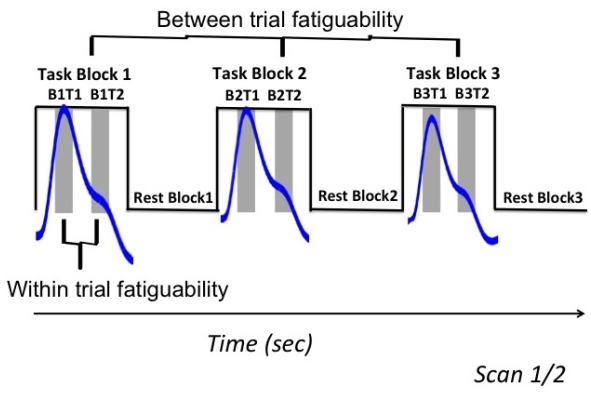Session Information
Date: Wednesday, June 22, 2016
Session Title: Parkinson's disease: Neuroimaging and neurophysiology
Session Time: 12:00pm-1:30pm
Location: Exhibit Hall located in Hall B, Level 2
Objective: To investigate the effect of fatiguability on brain activation in people with Parkinson’s (PwP) in comparison with healthy volunteers(HV).
Background: Fatiguability, an objective decline in amplitude of movement during sustained or fast repetitive motor tasks, is the obligatory component of the Parkinson’s disease Brain Bank criteria used in the clinical diagnosis of Parkinson’s, and yet an understanding of the underlying pathophysiology is limited(Friedman,2006). The aim of this study was to study the dynamic brain activation during serial finger tapping as used in the clinical diagnosis of PD to assess the neuronal correlate of fatiguability.
Methods: Fifteen HV(average age,66.27±4.9) and twelve medicated PwP(67.21±8.8; mean Hoehn&Yahr scale:1.6; disease duration<5y) underwent two motor BOLD fMRI tasks at 3T consisting of three alternating task and rest blocks of one minute duration. Participants were cued to tap a button with their index finger at full amplitude, keeping the finger fully extended, and as fast as possible while maintaining maximum amplitude. The tapping rate was recorded.A region of interest analysis was performed within 18 predefined motor areas.
Participants were cued to tap a button with their index finger at full amplitude, keeping the finger fully extended, and as fast as possible while maintaining maximum amplitude. The tapping rate was recorded.A region of interest analysis was performed within 18 predefined motor areas. Two brain activation fatiguability scores were calculated within and between trials as the ratio of the respective early to late BOLD amplitudes and between the task blocks (illustration see Figure1). We also assessed the disease effect by comparing the mean %BOLD change of the task blocks in HV with those in PwP.
Two brain activation fatiguability scores were calculated within and between trials as the ratio of the respective early to late BOLD amplitudes and between the task blocks (illustration see Figure1). We also assessed the disease effect by comparing the mean %BOLD change of the task blocks in HV with those in PwP.
Results: HV and PwP showed declining tapping rate within trials, but not between trials, and the effect was stronger in PwP in keeping, with obligatory fatiguability. Within-trial activation fatigue was demonstrated in all motor-related regions except the right inferior parietal lobe, right supplementary motor area(rSMA) and left dorsolateral prefrontal cortex in both groups. rSMA, which showed an increased %BOLD change during task in PwP compared to HV, also demonstrated an interaction between the effect of disease and fatiguability. This may indicate a crucial role for the SMA in attempting to combat motor fatigue in early Parkinson’s.
Conclusions: Both our behavioural and preliminary imaging evidence suggest that our repetitive finger-tapping fMRI protocol may offer an objective and easy technique to quantify fatiguability and may shed further light on the pathophysiology of motor fatigue in early-stage Parkinson’s disease.
To cite this abstract in AMA style:
Y. Xing, N. Bajaj, S.T. Schwarz, D.P. Auer. The feasibility of measuring fatigability in early-stage Parkinson’s disease using functional MRI [abstract]. Mov Disord. 2016; 31 (suppl 2). https://www.mdsabstracts.org/abstract/the-feasibility-of-measuring-fatigability-in-early-stage-parkinsons-disease-using-functional-mri/. Accessed October 17, 2025.« Back to 2016 International Congress
MDS Abstracts - https://www.mdsabstracts.org/abstract/the-feasibility-of-measuring-fatigability-in-early-stage-parkinsons-disease-using-functional-mri/
